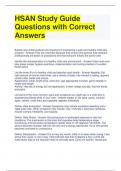HSAN Study Guide Questions with Correct Answers Explain why written policies are important in maintaining a safe and healthy child care program - Answer -They are important because they ensure that parents and childcare professionals are aware of procedures and that everyone follows the same rules Identify the characteristics of a healthy child care environment - Answer -Clean work and play areas, proper hygiene practices, implementation and routing practice of a written health policy List the three A's of a healthy child and describe each briefly - Answer -Appetite: Eat right amount of food at meal times, eat a variety of foods, has interest in eating, appears content after meals and snacks Appearance: Clear, bright eyes, clear skin, age appropriate muscles, gains steadily in height and weight Activity: Has lots of energy but not hyperactive, is alert, sleeps soundly, has few aches and pains List some of the most common signs and symptoms you might see in a child who is experiencing illness while in your care - Answer -weepy or red eyes, sores, unusual spots, rashes, looks tired, poor appetite, appears distressed Define: Heat Exhaustion - Answer -Symptoms may include excessive sweating and a rapid pulse rate. Other symptoms may include: cool, moist skin, dizziness, faintness, muscle cramps, headache, and nausea. Define: Heat Stroke - Answer -Occurs because of prolonged exposure to very hot conditions. The mechanism in the brain that regulates body temperature stops functioning, and the body's temperature rapidly rises to 104 degrees Fahrenheit. The person becomes flushed, with hot, dry skin and a strong, rapid pulse. He or she quickly becomes confused or unconscious Define: Dehydration - Answer -Dry to very dry mouth. Little or no tears when crying. Less active than usual, or very fussy. Infant will wet less than 6 diapers a day; a child will make fewer trips to the restroom than he normally does. Eyes are sunken. Hands and feet are cool and blotchy. Pulse may seem weak and fast. Child will not urinate for hours. Define: Bacteria - Answer -Small organisms seen with an ordinary microscope, can cause strep throat, impetigo, pinkeye, and some pneumonia. Antibiotics help stop growth Define: Virus - Answer -Smaller than bacteria and grow only in living cells. They can cause colds, chicken pox, measles, German measles, mumps. Antibiotics have no effect, so rest is the best action; body fights better when rested.Vaccines against common viruses are available Define: Fungi - Answer -Grow best in warm, moist places, can cause athlete's foot and ringworm. Effective medication is available. Medications work best when conditions favorable to fungal growth are removed Define: Parasites - Answer -Organisms that live on or in animals and people. Common examples include pinworms, roundworms, head lice. Effective medications are available for most List the four methods through which diseases are transmitted - Answer -Respiratory, fecal/oral, direct contact, and blood borne List three ways of preventing communicable disease. - Answer -Isolation, immunization, and sanitation Define the term Standard Precautions and give three examples of how to use it in a child care program. - Answer -Standard Precautions are a set of infection control practices used to prevent transmission of diseases that can be acquired by contact with blood, body fluids, non-intact skin (including rashes), and mucous membranes. Three examples: 1. Wear gloves, 2. Wash hands thoroughly 3. Don't get body fluid in eyes, nose, mouth, or open sore. Explain how isolation and immunization can be used to control communicable disease - Answer -Isolation keeps a sick child from infecting healthy children. Immunization helps to prevent diseases in the first place. List items that should be sanitized as often as possible - Answer -Items that have close contact with the children (things that go in their mouths, things that touch food, etc.) Describe the appropriate handwashing technique used to prevent the spread of germs - Answer -1. Wet hands 2. Apply soap 3. Rub soapy hands for 20 seconds 4. Scrub fingertips & between fingers 5. Scrub forearm to just below elbow




